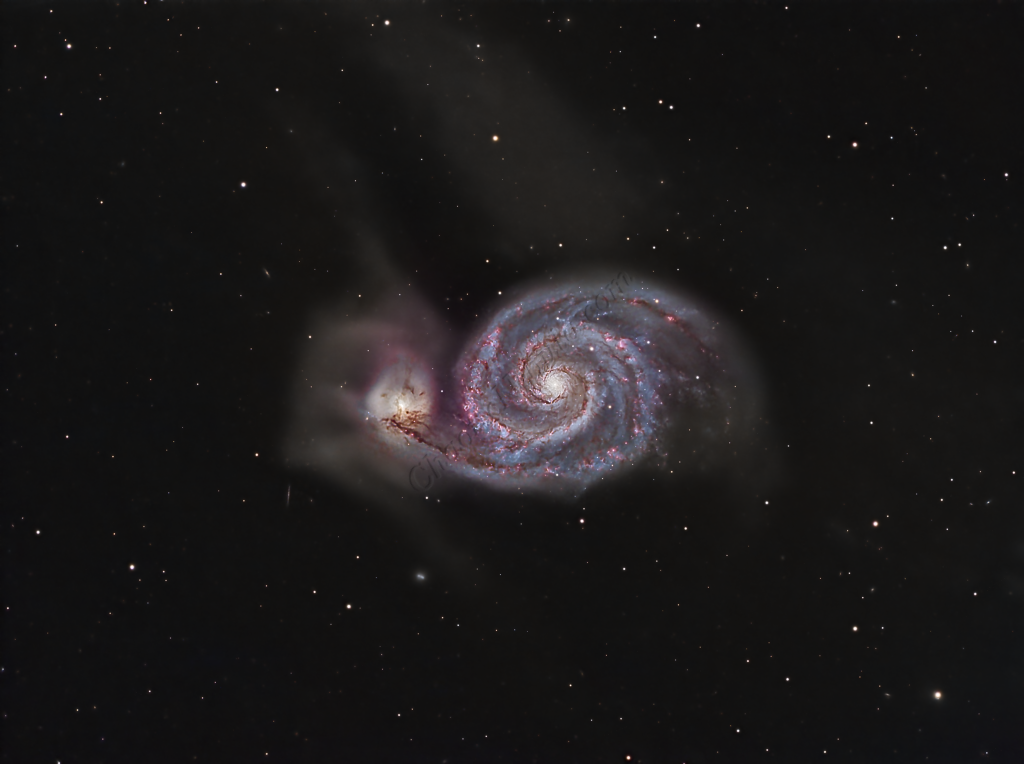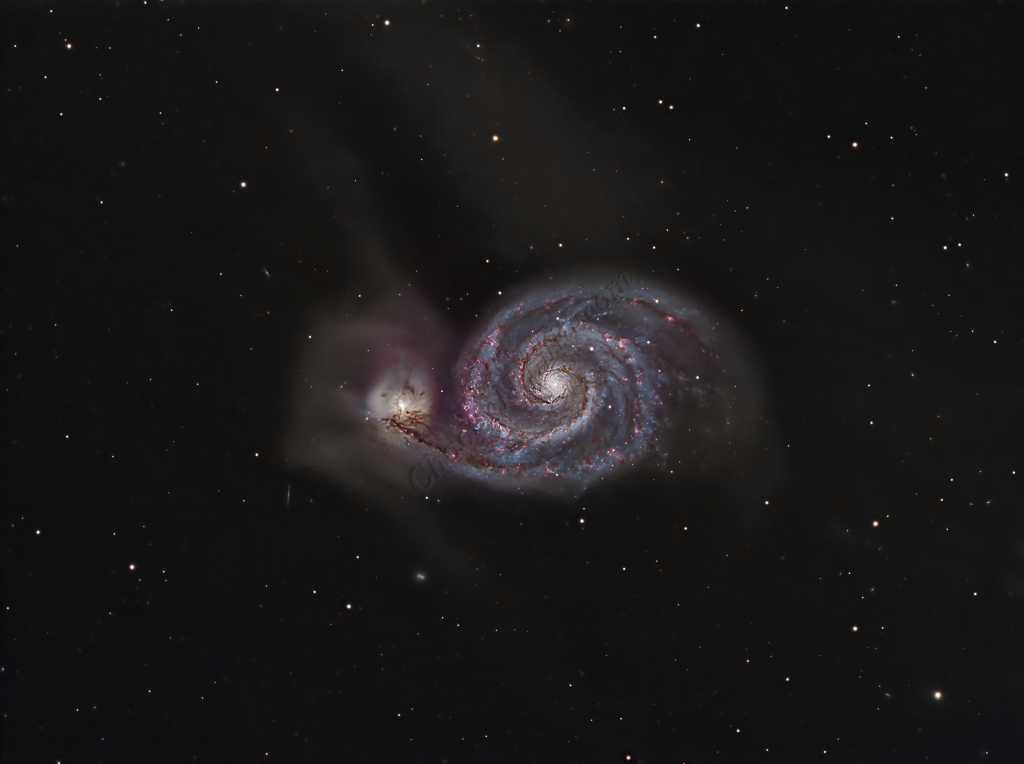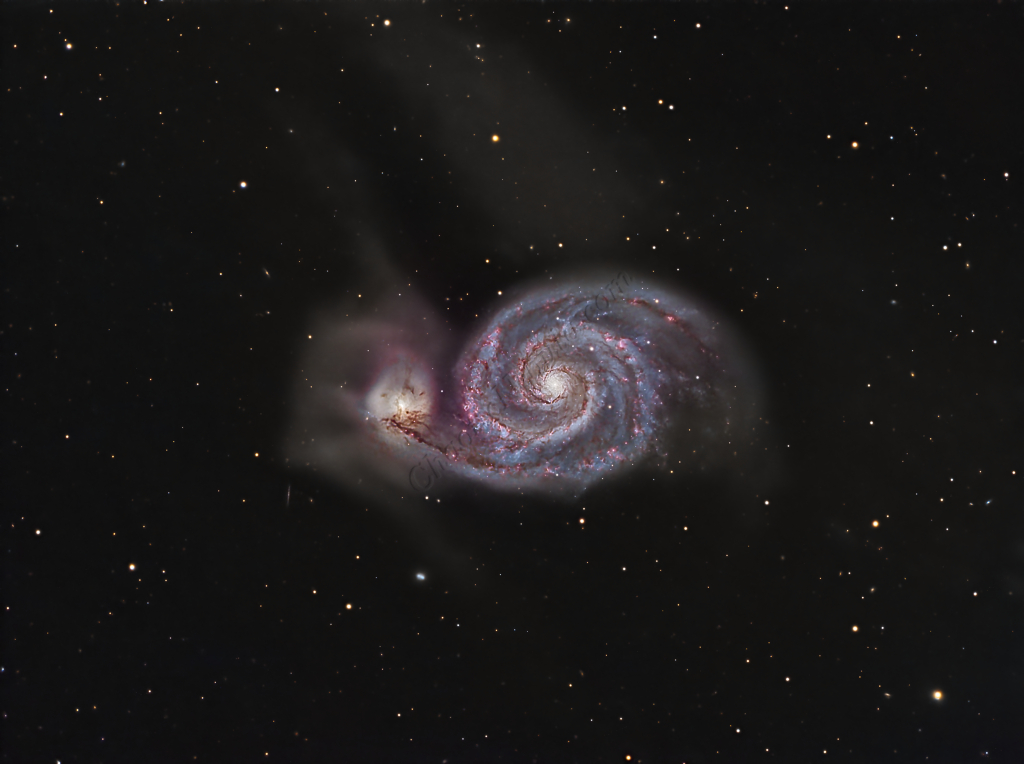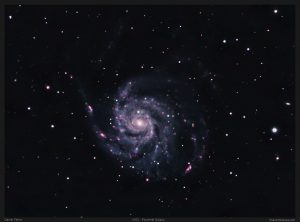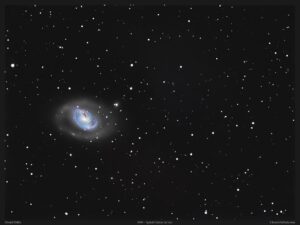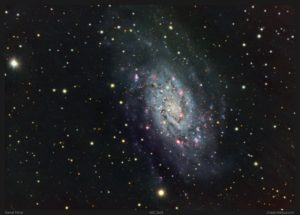M51, a captivating spiral galaxy nestled approximately 23 million light-years away in the constellation Canes Venatici, stands as a marvel of celestial symmetry. Its graceful spiral arms sweep elegantly around a prominent central bulge, creating a striking visual impression.
The intricate dark dust lanes threaded through M51’s spiral arms are pivotal to the galaxy’s ongoing cycle of stellar birth. These dense clouds of dust and gas serve as the cosmic nurseries where new stars are born. Gravity compacts these materials until they ignite into brilliant, newborn stars through the process of nuclear fusion. These areas take on a reddish hue thanks to the integration of the hydrogen-alpha narrowband filter.
For astrophotographers, M51 is an irresistible subject. Its sizable appearance and moderate luminosity make it accessible to telescopes of various sizes and capabilities. By employing advanced imaging techniques and specialized filters, observers can capture the intricate details of M51’s spiral structure, dust lanes, and clusters of young stars.
The interaction between M51 and its companion galaxy, NGC 5195, adds a fascinating dimension to the astrophoto. NGC 5195, also known as M51b or IC 4258, is a smaller, dwarf galaxy that appears to be interacting with M51, possibly through gravitational forces.
Located approximately 37,000 light-years away from M51, NGC 5195 is tidally interacting with its larger companion. This interaction is evident in the distorted shape of NGC 5195’s outer spiral arms, which appear to be pulled and stretched by M51’s gravitational influence. Such interactions can trigger intense bursts of star formation as gravitational forces compress gas and dust within the galaxies.
Imaging Details
- Workflow: Broadband workflow for Galaxies
- Red: 60*600 seconds
- Green: 60*600 seconds
- Blue: 60*600 seconds
- HA: 60*600 seconds
- Total Imaging Time: 40 hours
- Imaging Dates (12 nights):
- 12/11/2021
- 12/12/2021
- 1/2/2022
- 1/9/2022
- 1/27/2022
- 2/25/2022
- 2/26/2022
- 3/7/2022
- 3/9/2022
- 3/11/2022
- 3/26/2022
- 3/27/2022
Imaging Notes
I’ve tried to image this galaxy multiple times over the course of a decade, each with varying results.
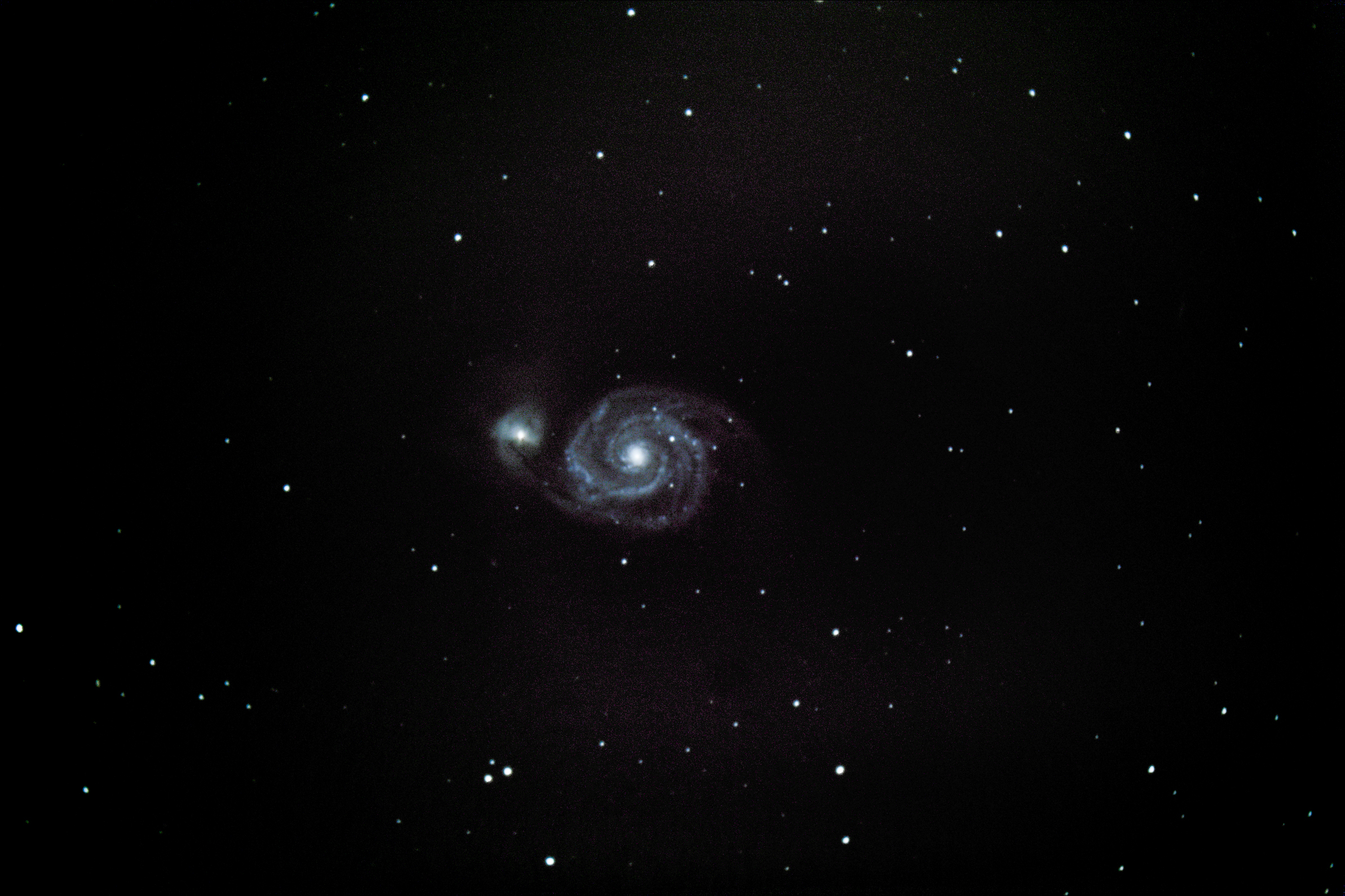

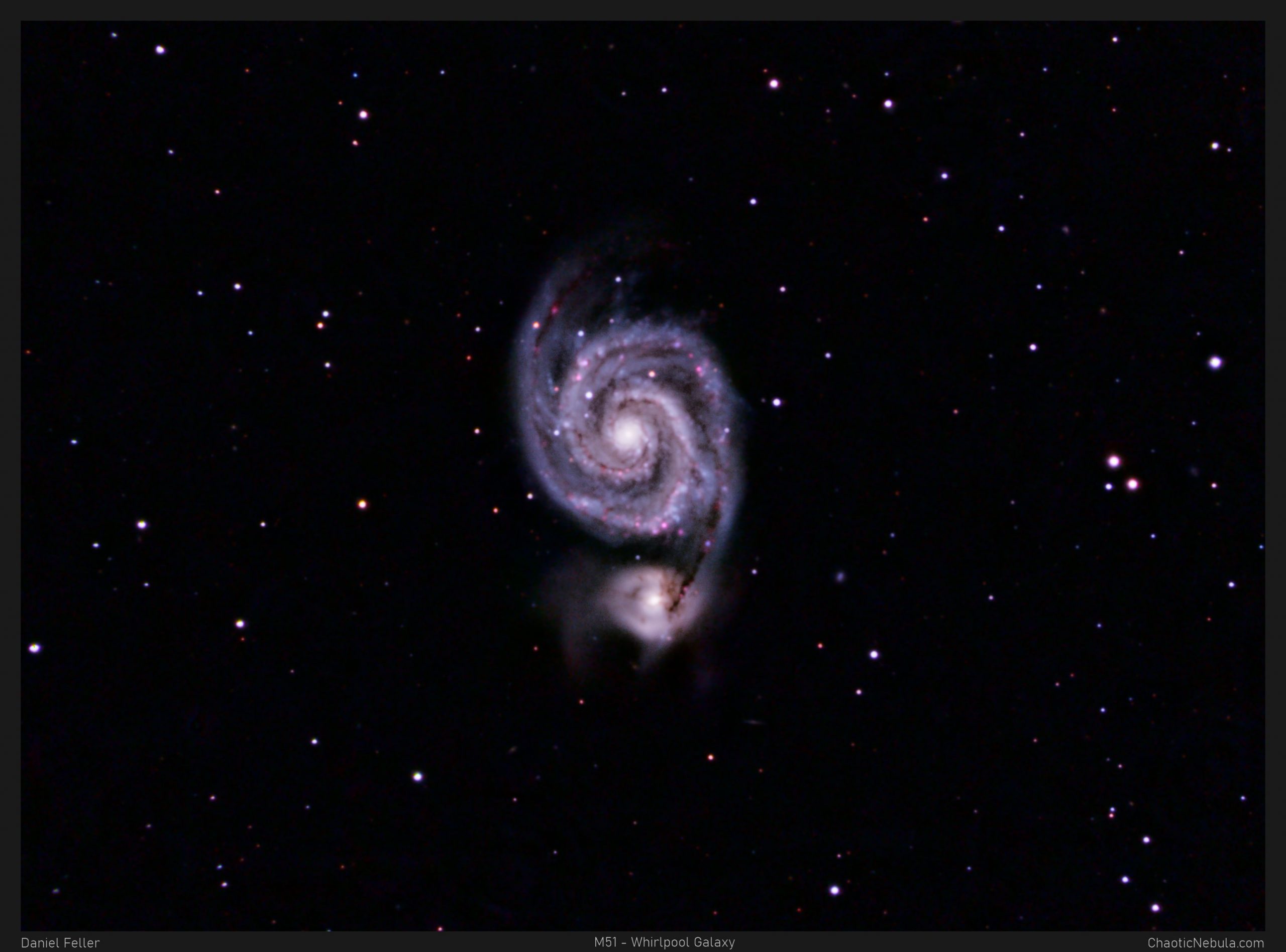
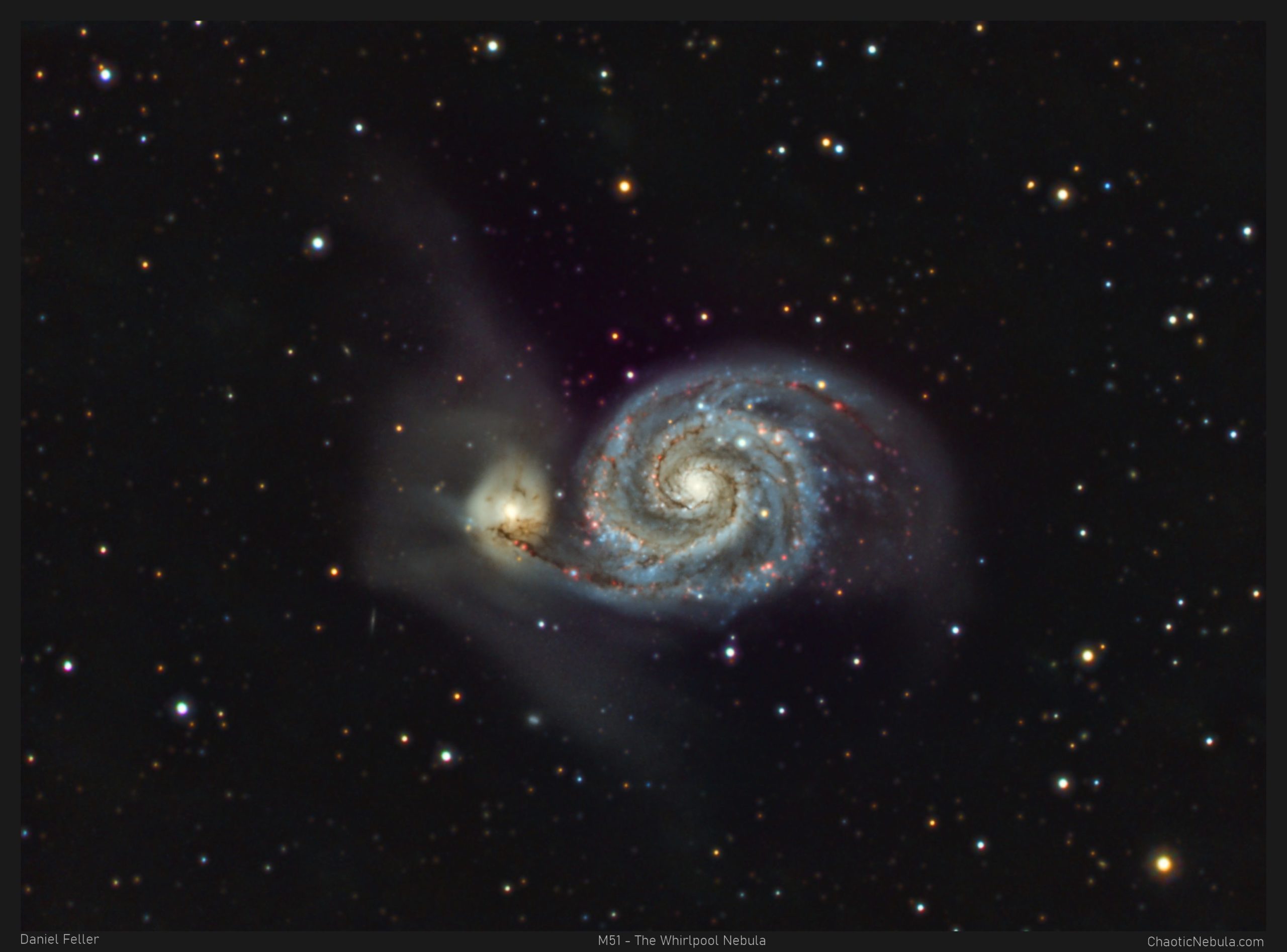
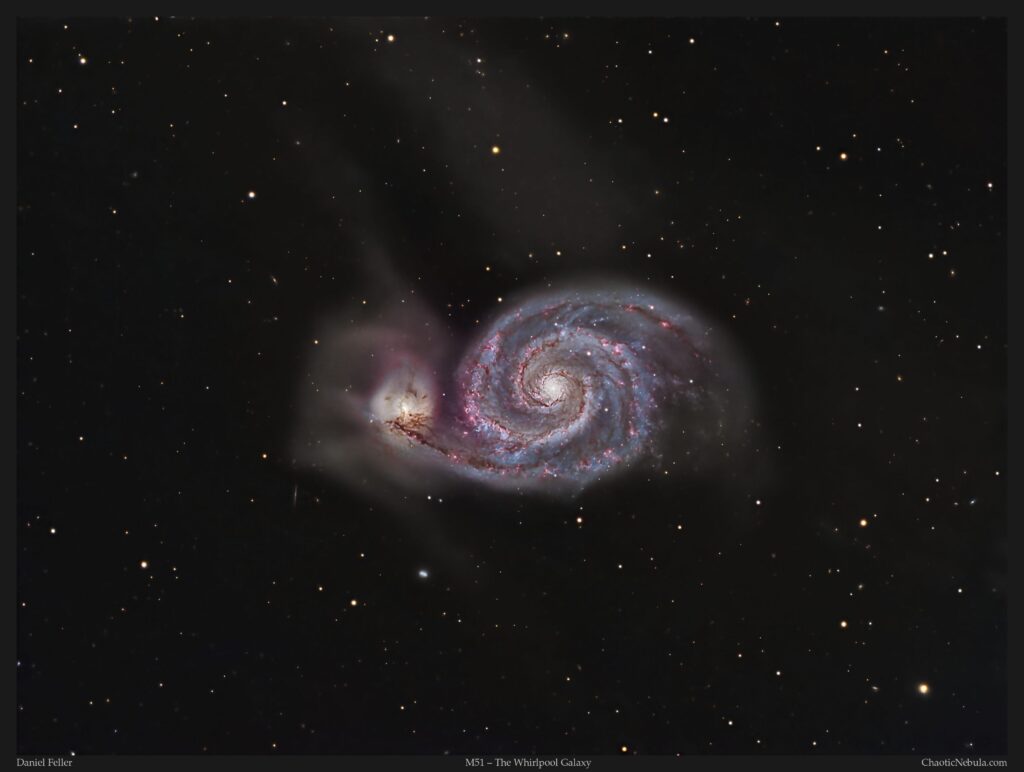
2013: In 2013, I tried this using the Meade LX200 12 inch telescope, with the factory mount and a Canon T1i DSLR. Picture turned out decently, especially for some of my earlier attempts at astrophotography. I was limited to 30 second exposures due to the poor tracking of the standard Meade mount. After aligning and stacking my images with Deep Sky Stacker (DSS), I used Adobe Lightroom to do my photo editing.
2017: Five years later, I upgrade the mount to a Losmandy G11T. My camera also got a minor upgrade to a Canon T5i. I was able to take longer exposures (90 seconds). I again used DSS and Lightroom for the photo editing. This image was better than the one taken in 2013, but I’m missing a lot of the details and brightness due to the light pollution in my area, Bortle Scale 6.
2019: I then upgraded my camera to a monochrome CMOS camera (ZWO ASI 1600mm) with an integrated filter wheel. I also started using PixInsight for all of my image editing. Even though my exposure is still limited to 90 seconds, due to light pollution, the details are much better than what I was able to get in 2017 due to a better camera and better software specifically designed for astrophotography.
2022: In 2022, I upgraded my focal reducer, which was the cause of a lot of my RGB image challenges. The old reducer (meant for visual astronomy) caused many internal reflections that were impossible to remove with image calibration frames. I upgraded to Starizona’s focal reducer. Results are spectacular. I’ve now determined that I can take RGB and HA images with 10 minute exposures, even with light pollution. I’ve ale drastically updated my PixInsight workflows for LRGB+HA images plus created a new workflow for the luminance channel.
2024: Over the years, I’ve learned a lot about the numerous processes in PixInsight. I’ve continued updating my workflows to create better images. The image in 2024 uses the same data as the 2022 image and the result is much better. I used the Broadband workflow for Galaxies and leveraged BlurXTerminator and NoiseXTerminator as part of this process.
Imaging Workflow
This image followed the Broadband workflow for Galaxies
I ran through the normal process of doing star removal early on. However, because this galaxy is so large and bright, the star removal technique removed detail within the arms of the galaxy. Although these would have been added back in at the end of the image processing workflow, the overall sharpness of the galaxy was poor. By keeping the stars integrated for the entire workflow, allowed for a better end result. With the stars present during the workflow, a more complex image stretching technique was required to prevent the stars from bloating. This is explained in the Luminance workflow section below.
Integrated Image
I started off with three images for red, green, and blue filters. I did my normal integration process using the PixInsight Weighted Batch Preprocessing Script.
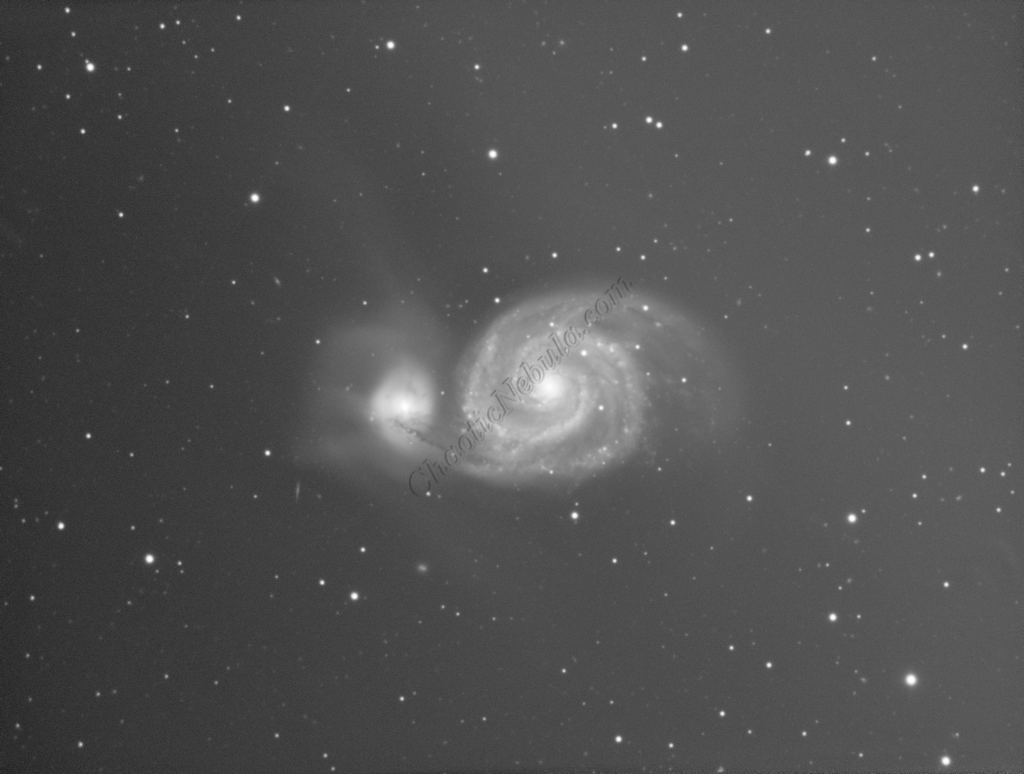
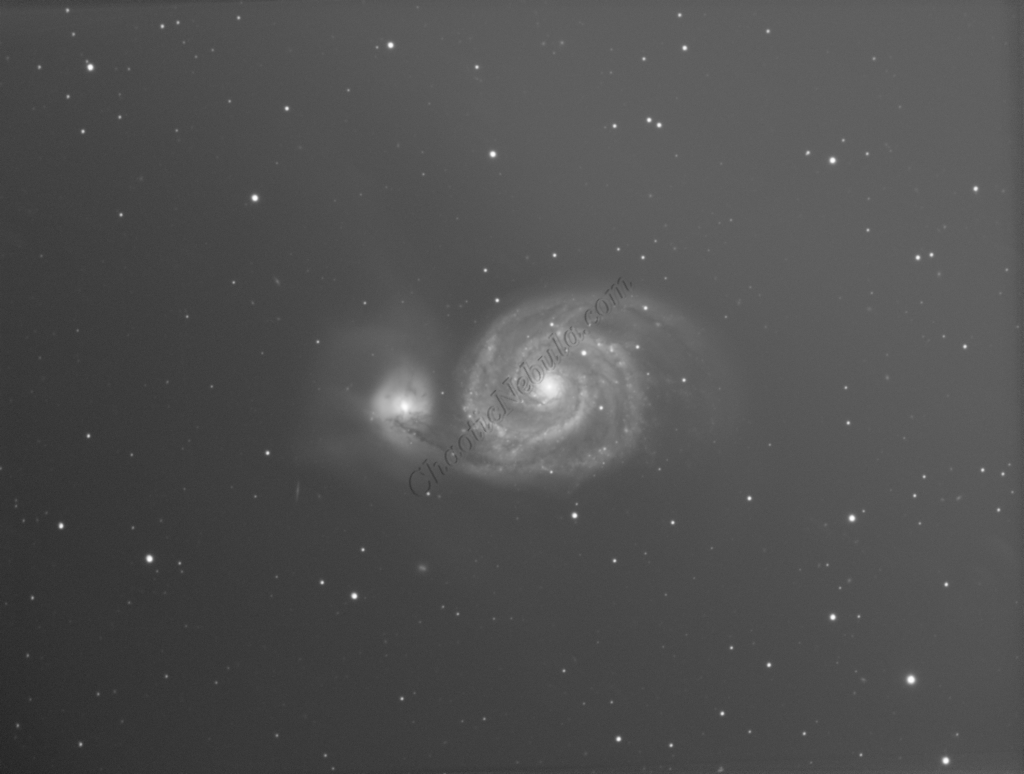
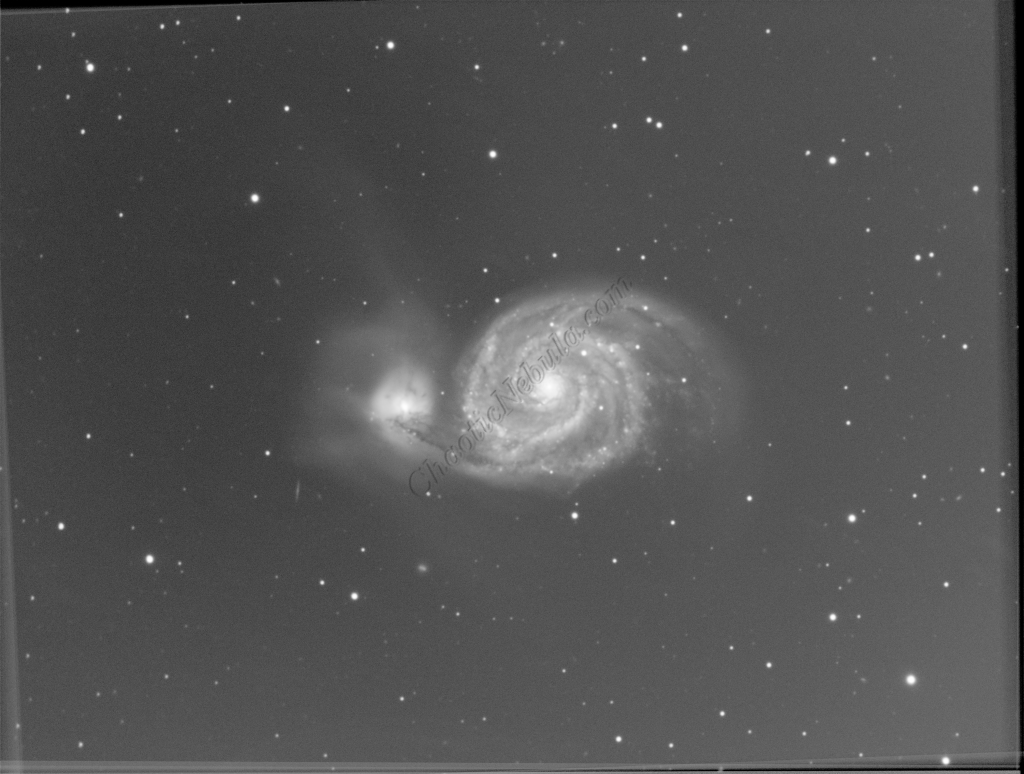
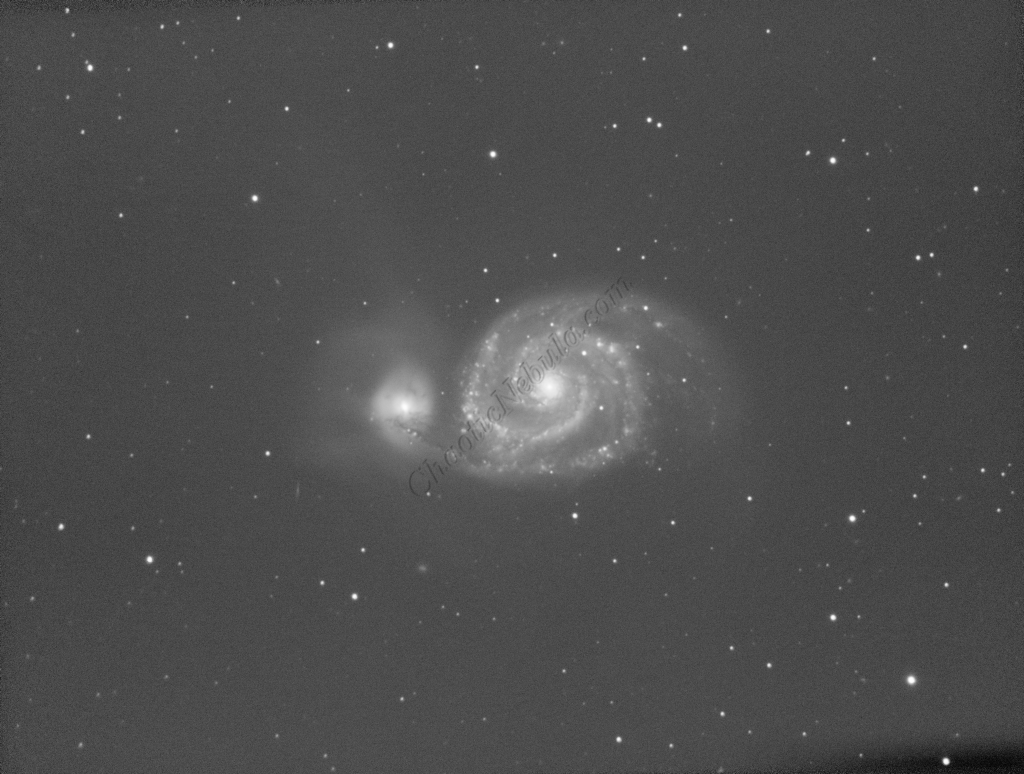
Gradient Correction
The Gradient Correction process made it easy to remove the extreme darkness/brightness around the edges.
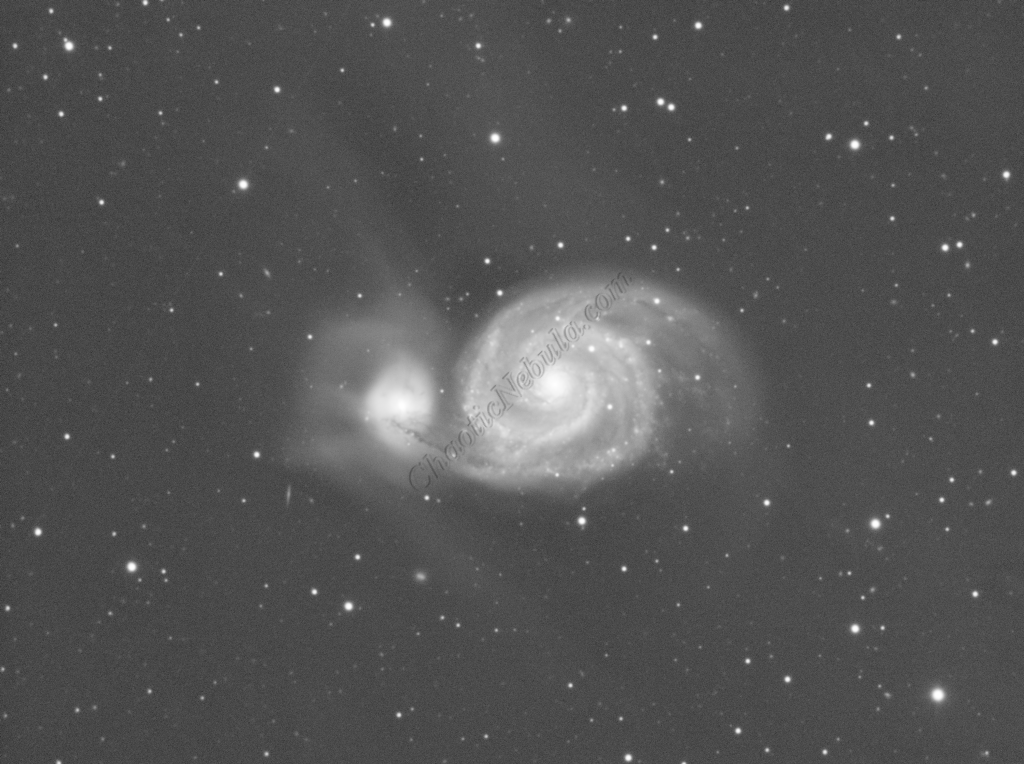


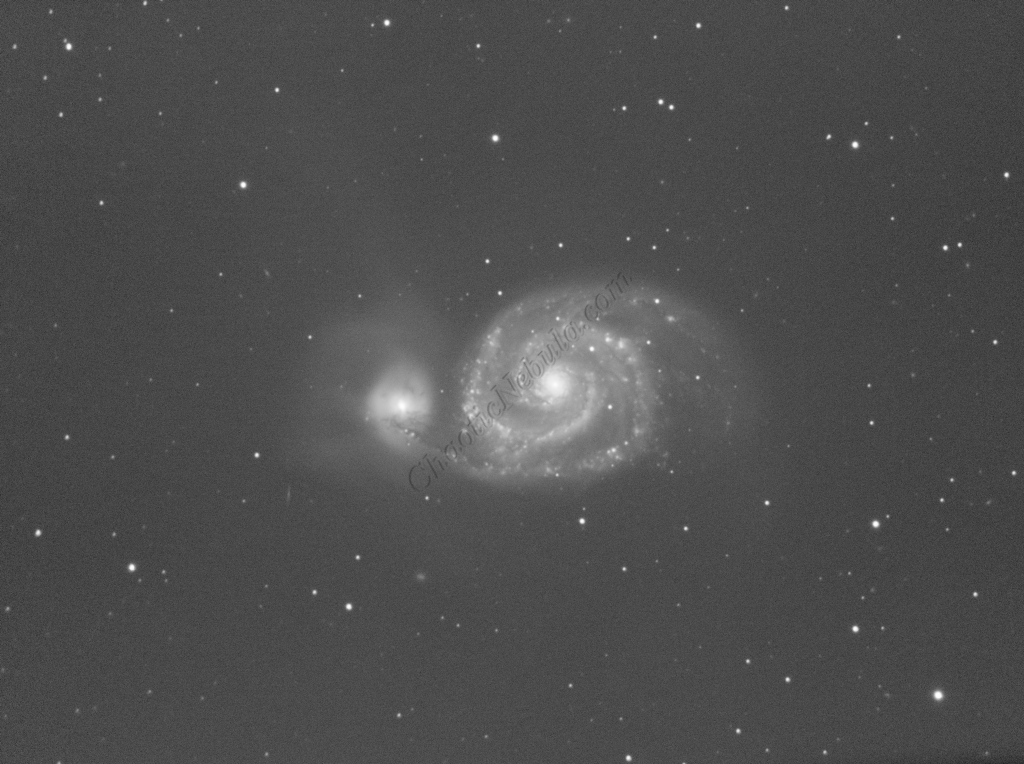
Deconvolution
BlurXTerminator is applied two times. The first time is for Correction only. This takes care of the coma (blurring of stars along the edges).
The second application of BlurXTerminator handles deconvolution, which improves the sharpness and details of the nebula while removing the blur from the image.
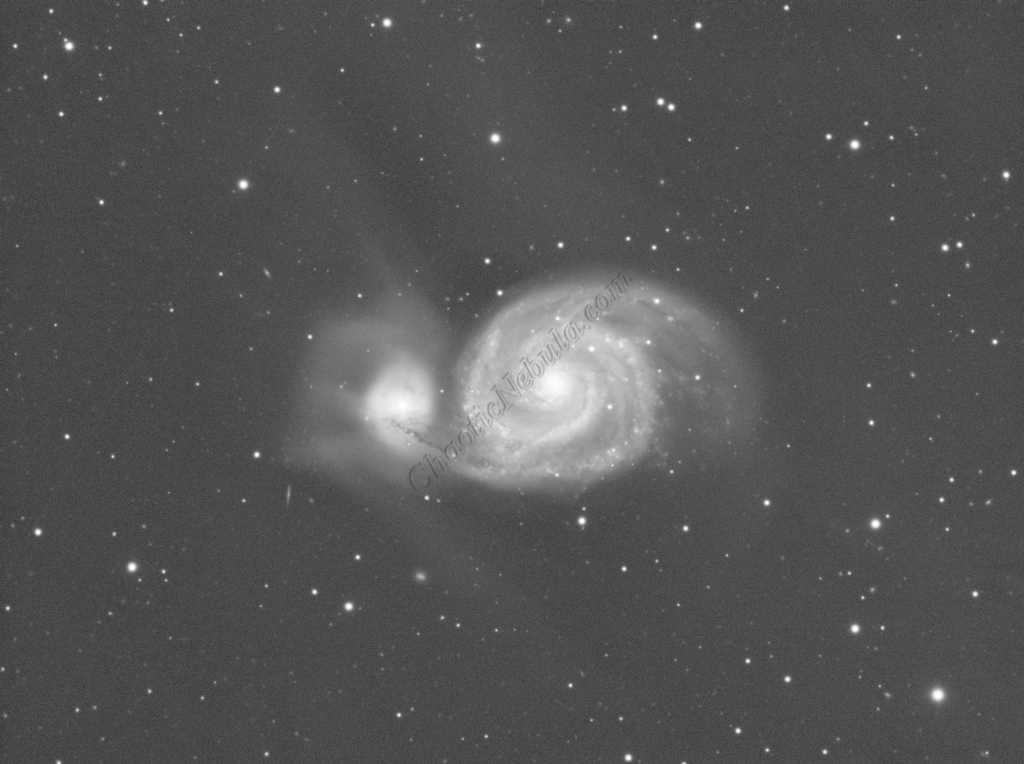
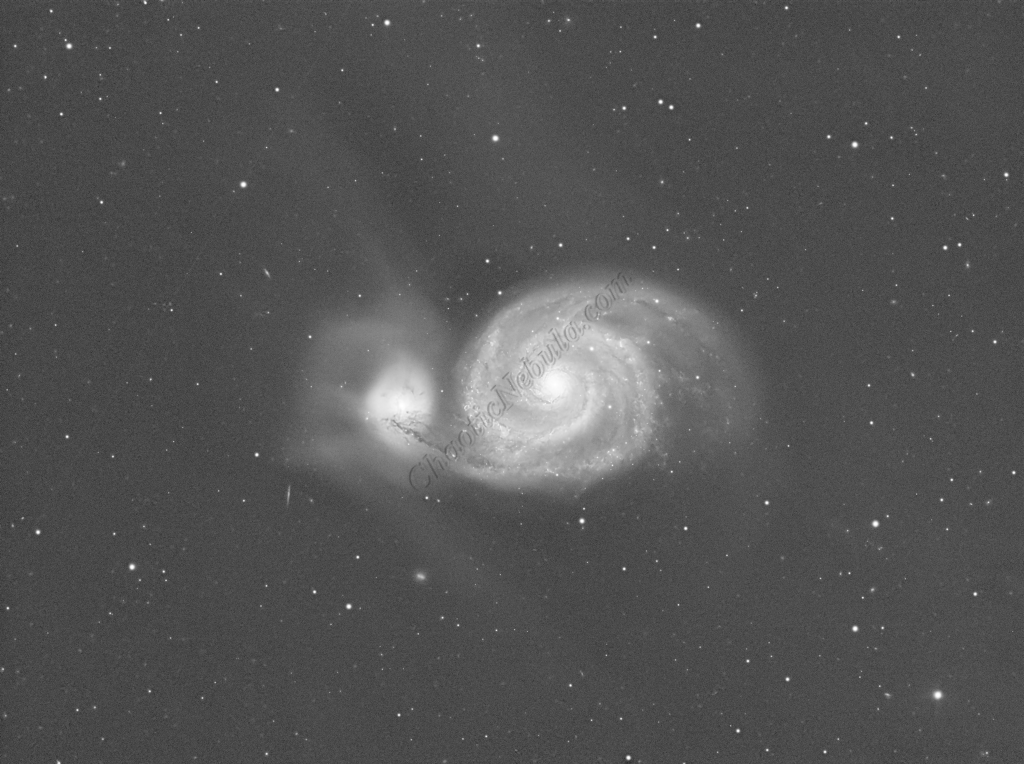
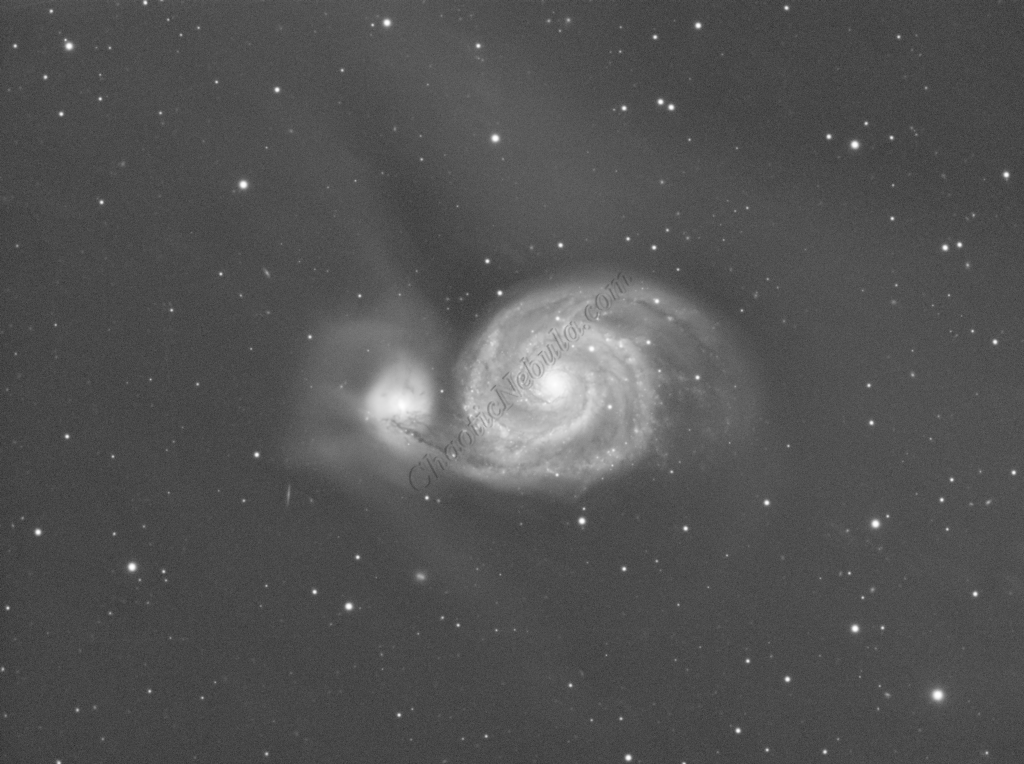

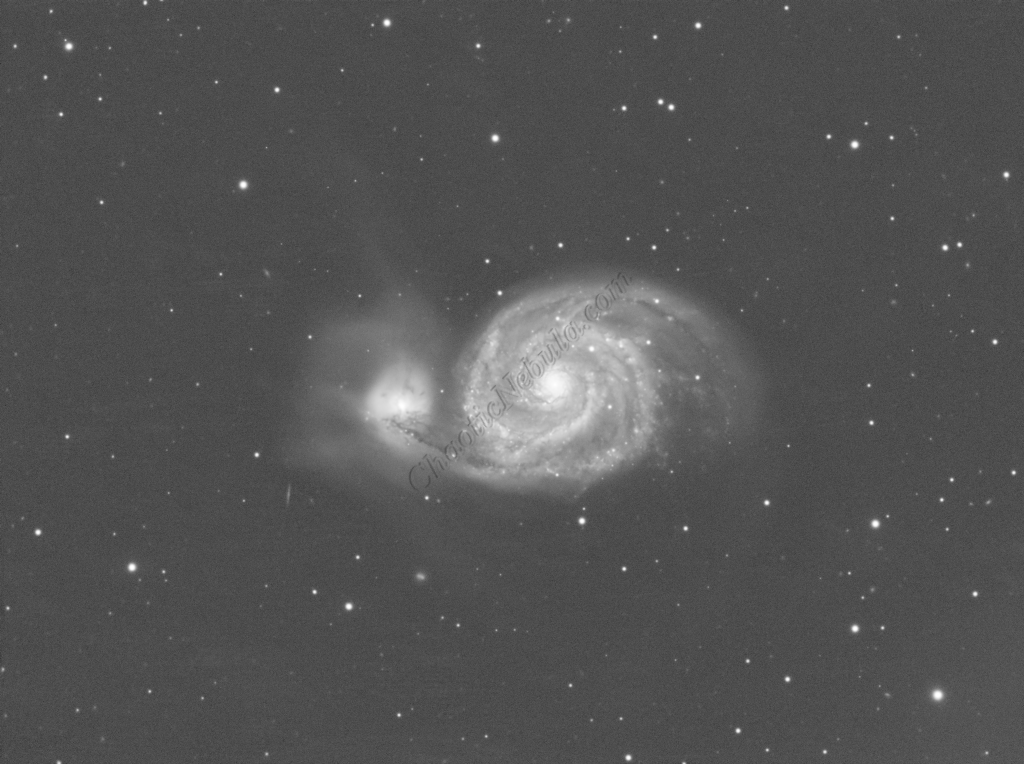

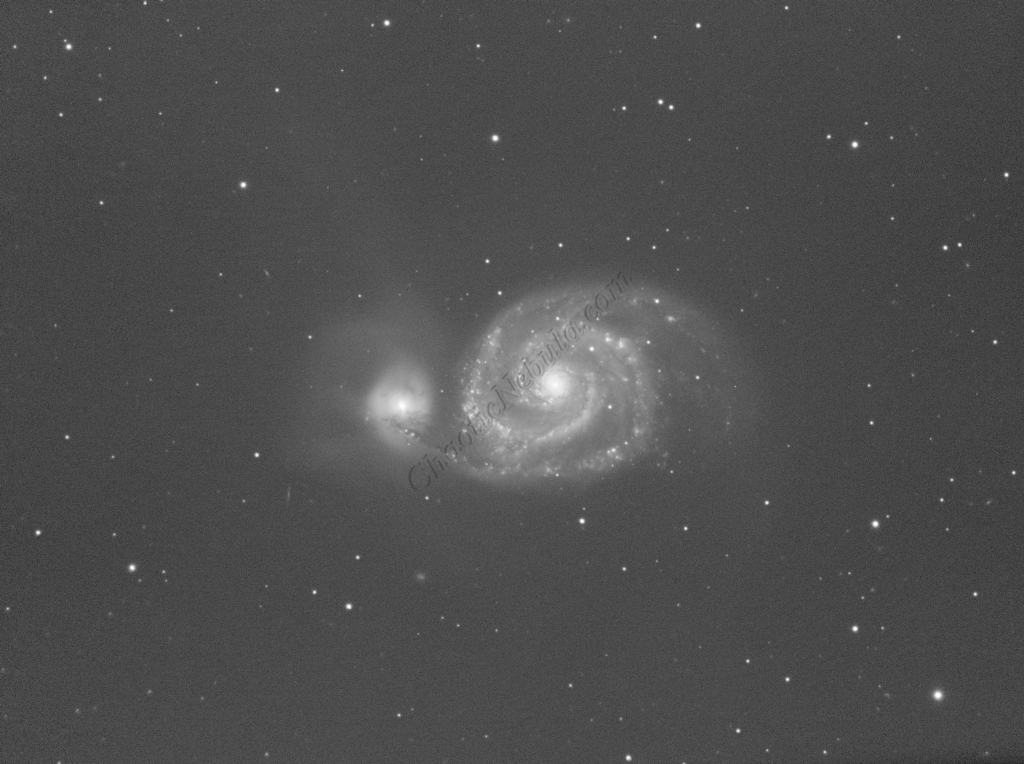
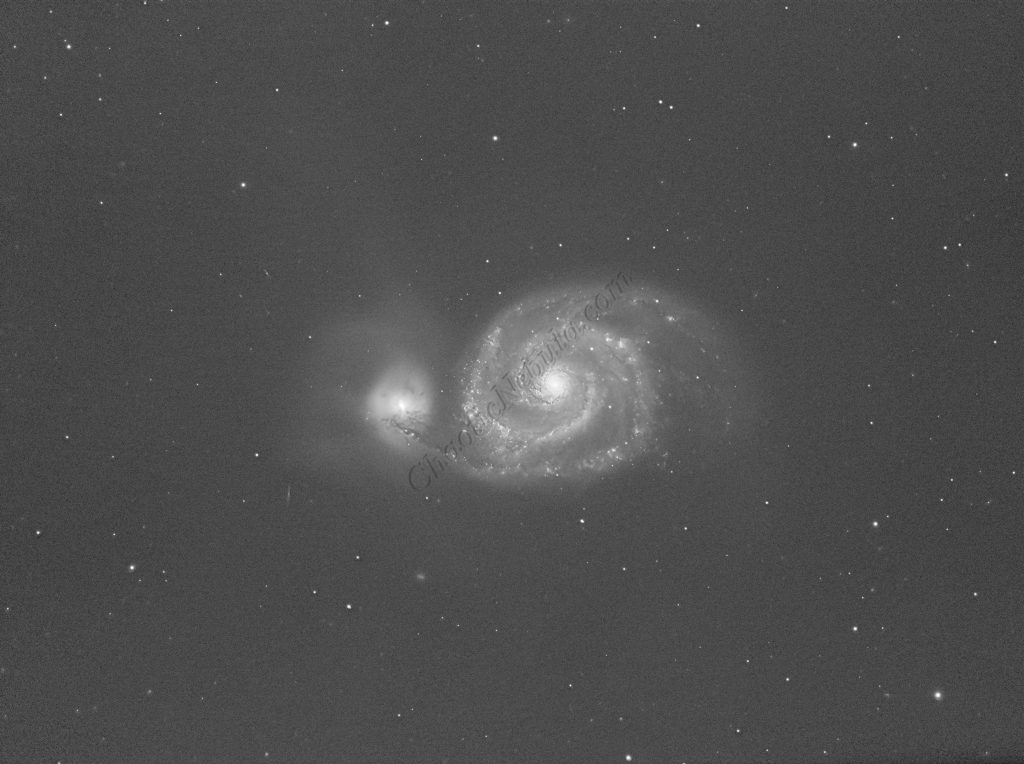
Noise Reduction
With the blurring corrected, it is time to do noise reduction. This time I used the new NoiseXTerminator add on.
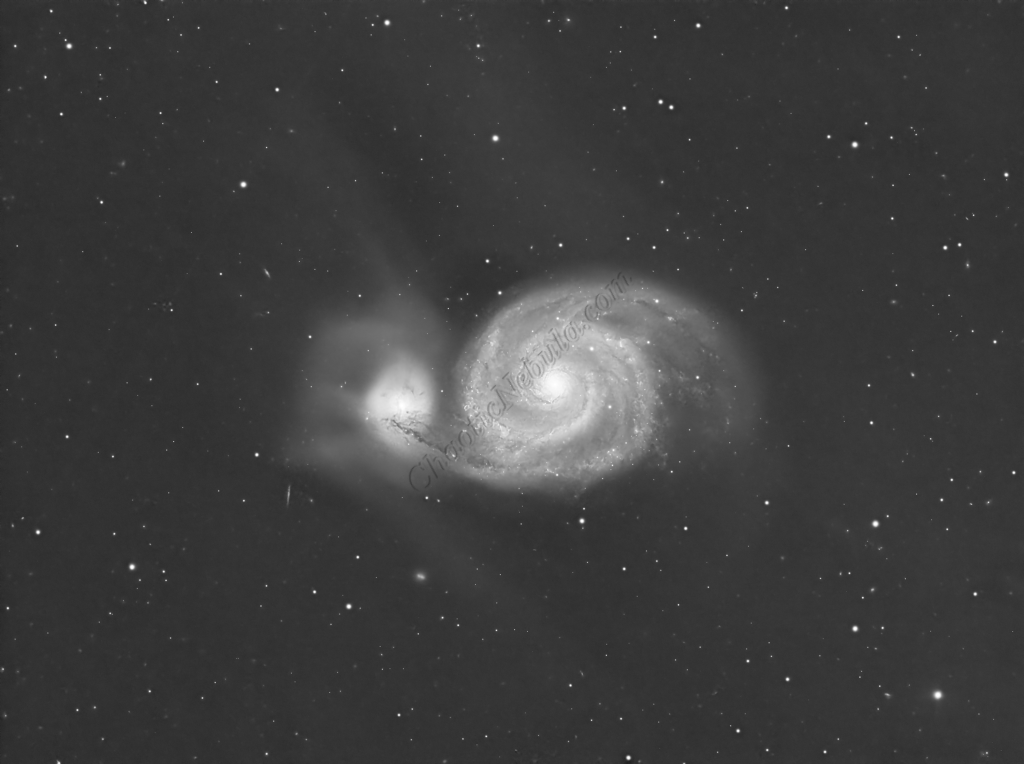
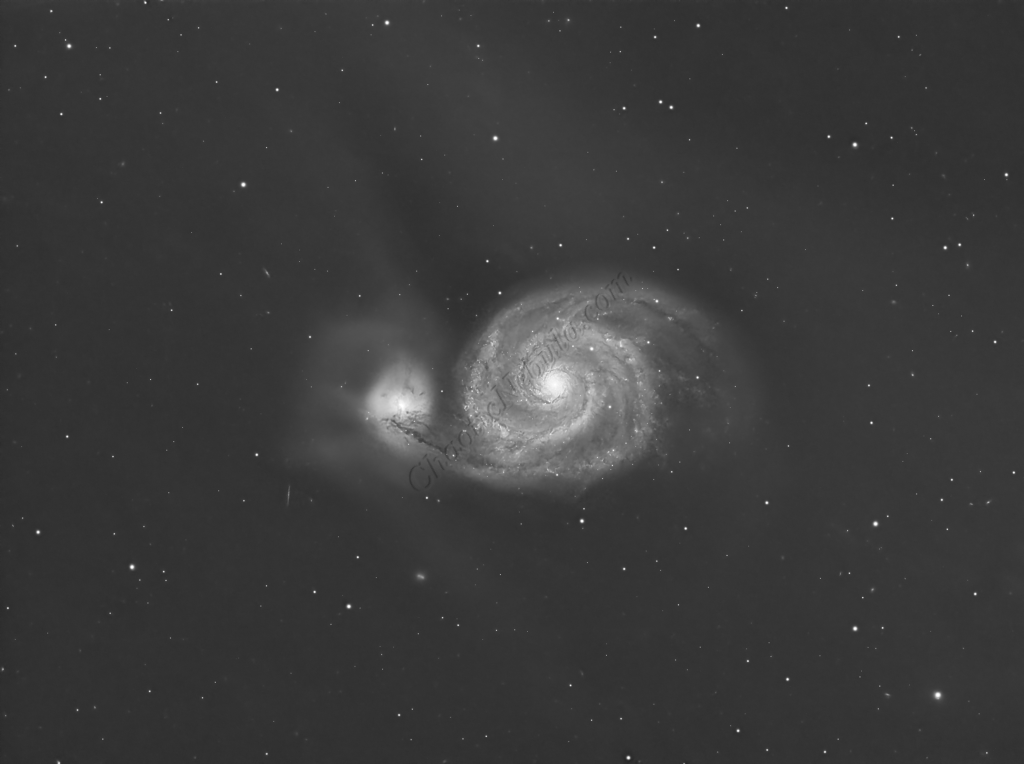
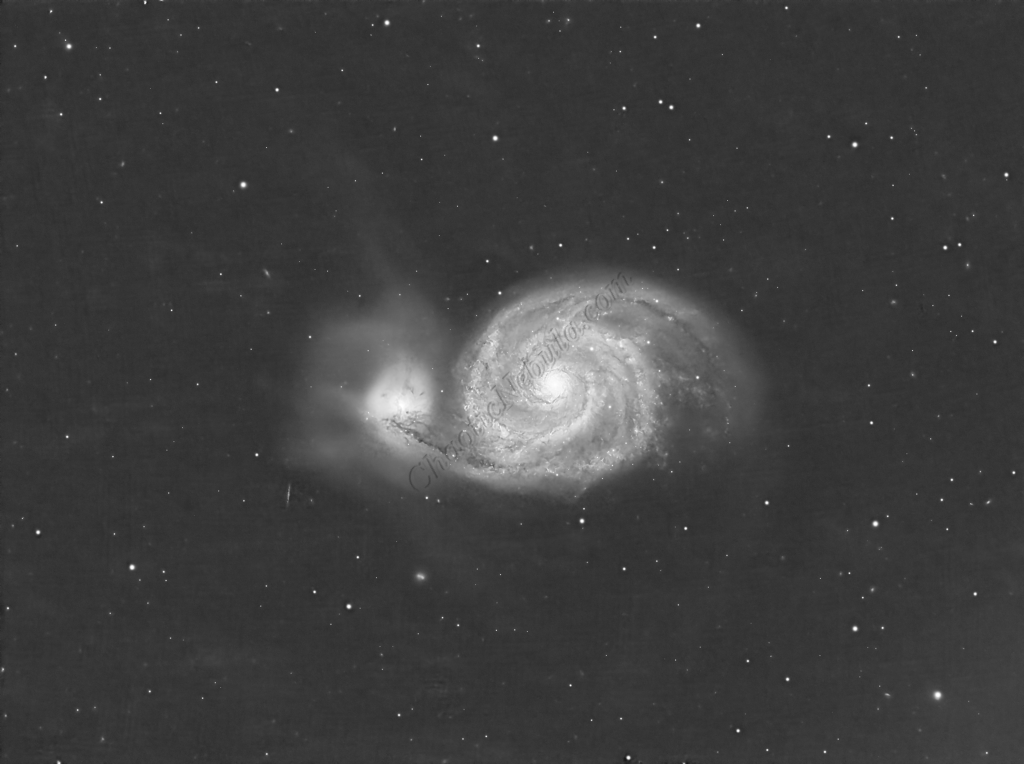

Channel Combination for RGB
The next step is to do a Linear Fit and then a Channel Combination to combine the channels into RGB.
In addition, once the color image was created, the luminance channel was extracted to be used for the luminance workflow.
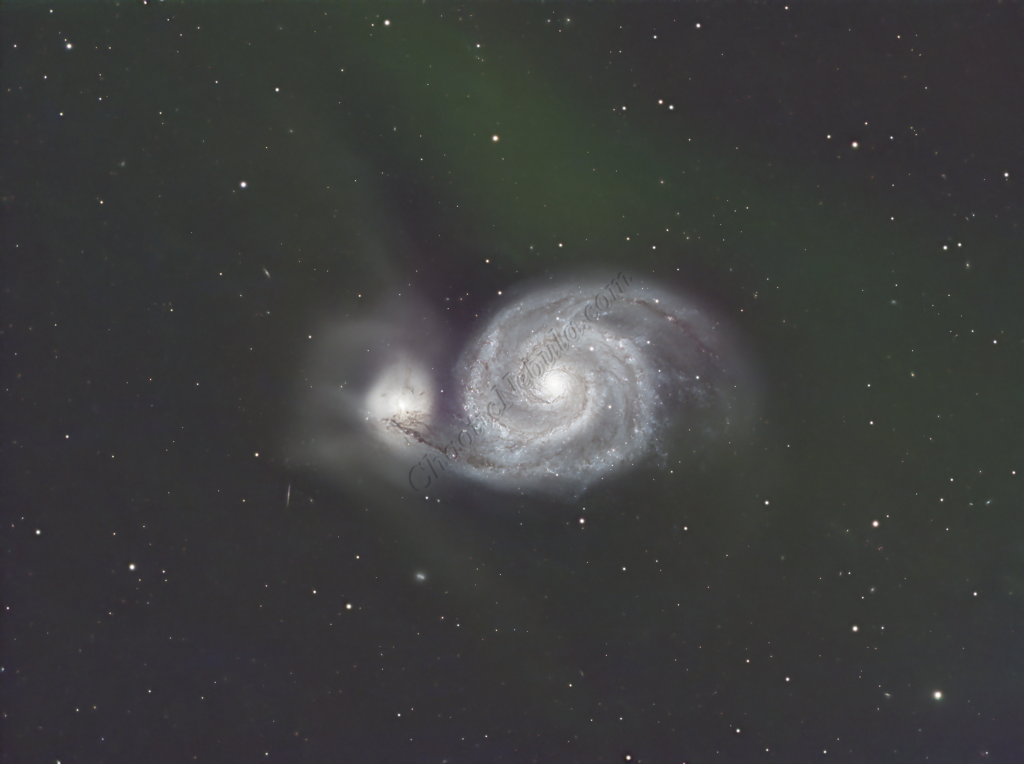
Color Calibration
To align the colors, Spectrophotometric Colo Calibration was applied, which uses the Gaia dataset.
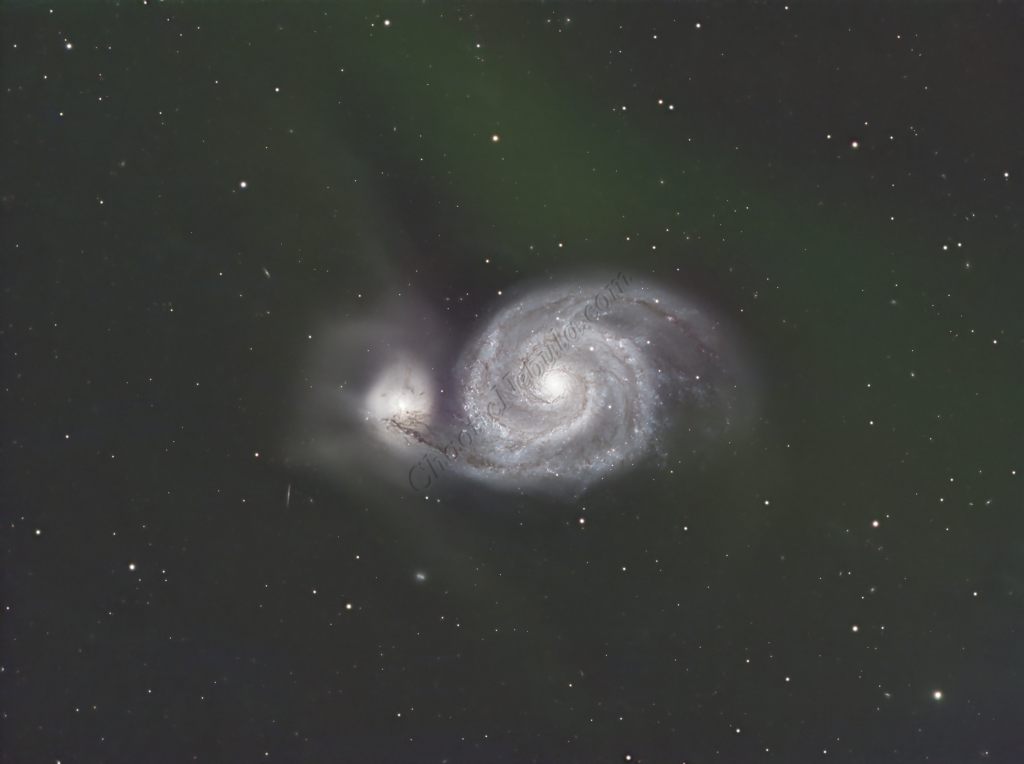
Narrowband Integration
The hydrogen-alpha image was integrated into the RGB image in order to enhance the red channel. This use the Narrowband Integration (LRGB+HA) process of Pixel Replacement Multiplier with a strength of 0.25.
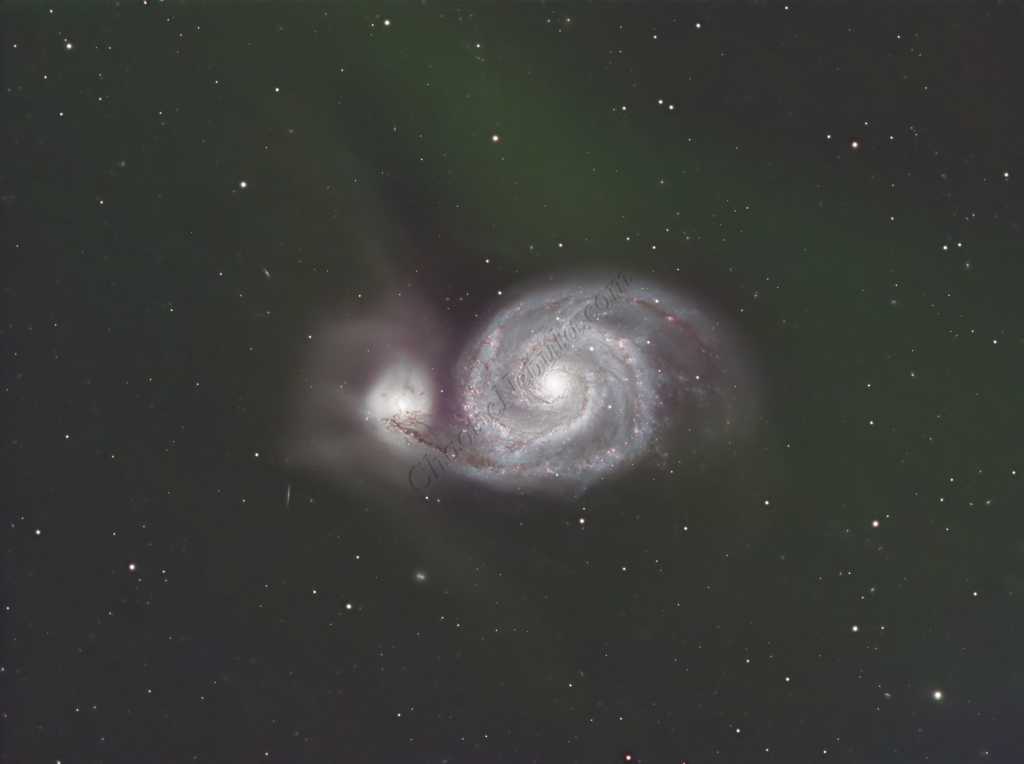
Histogram Stretch
Color Saturation
PixInsight Curves Transformation increased the overall color saturation.
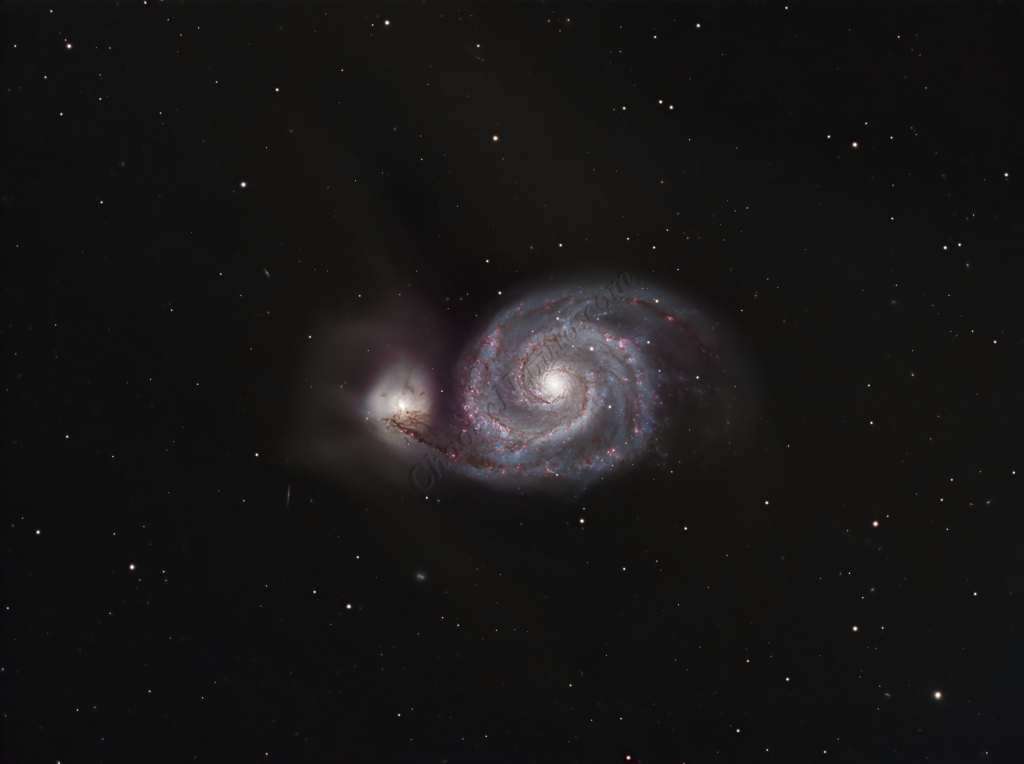
Luminance Workflow
Before doing anything more to the color image, it is time to go through the Luminance Workflow.
Because the stars were not removed from the image, the stretching to non-linear did the initial stretch by using masked stretch with exponential transformation. This helped reduce the impact a stretch would have on bloating the stars. Once complete, histogram transformation was used to complete the stretch.
To learn more about this approach, review the Image Stretching Techniques for Better Astrophotos tutorial.
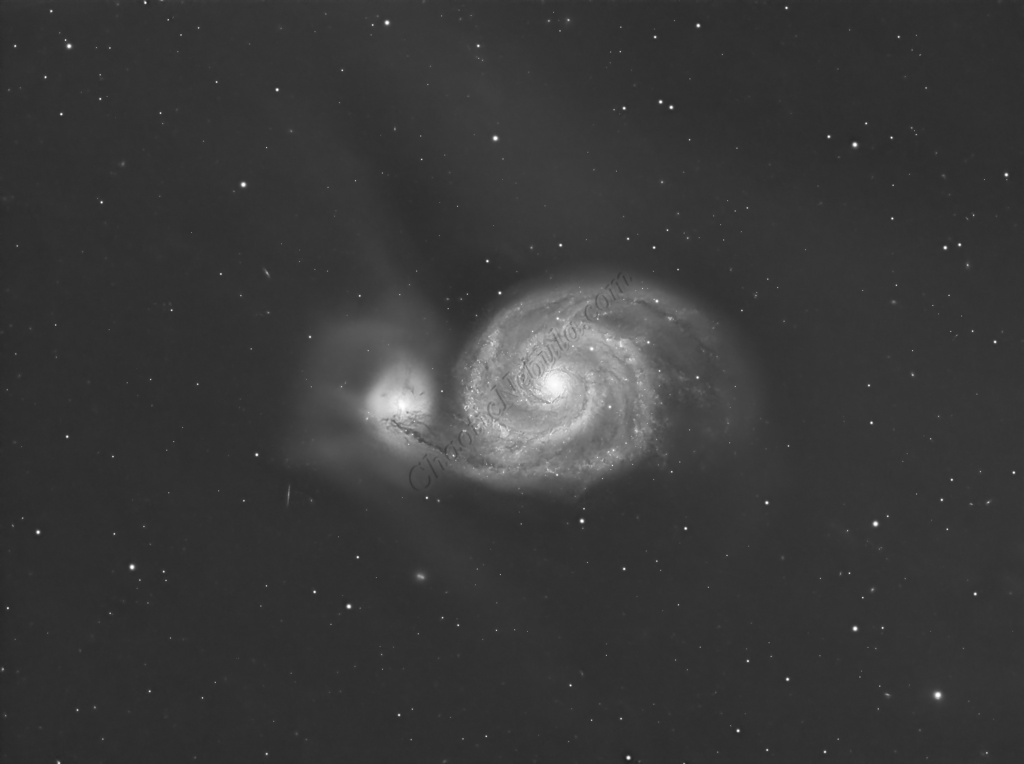

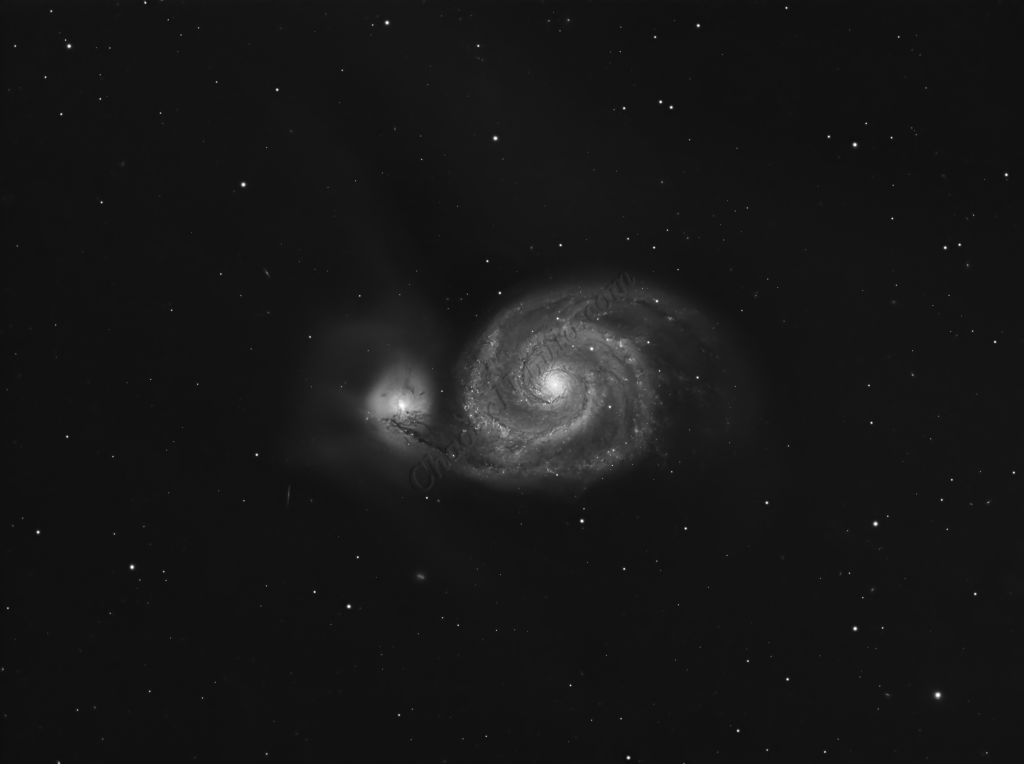
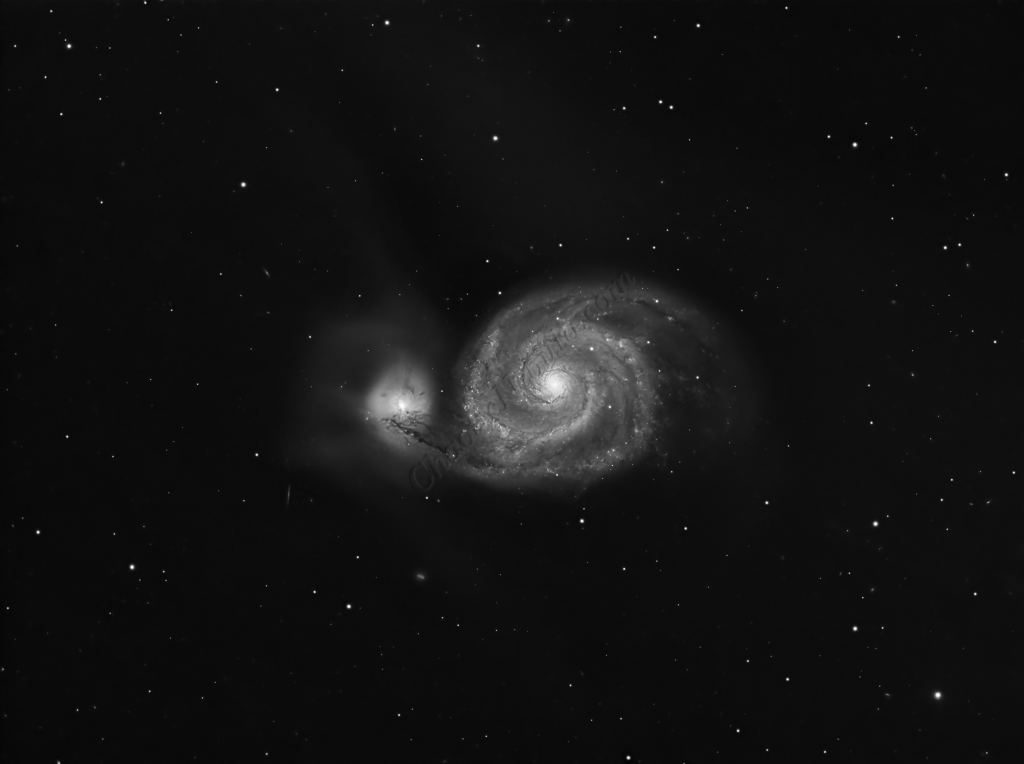
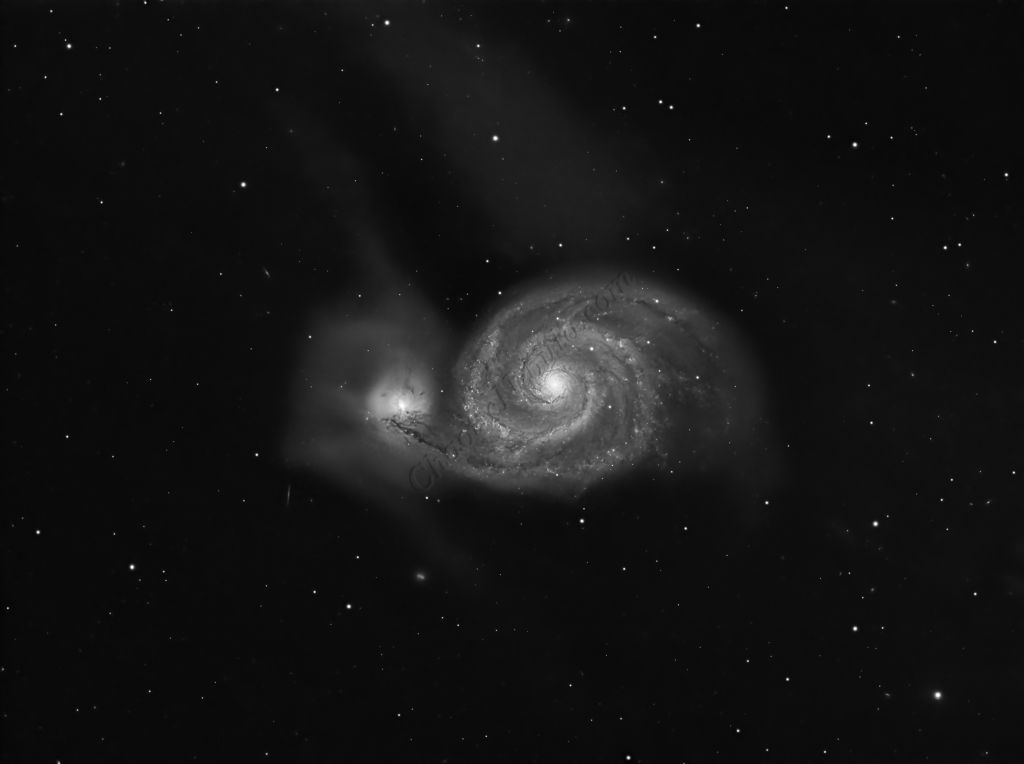
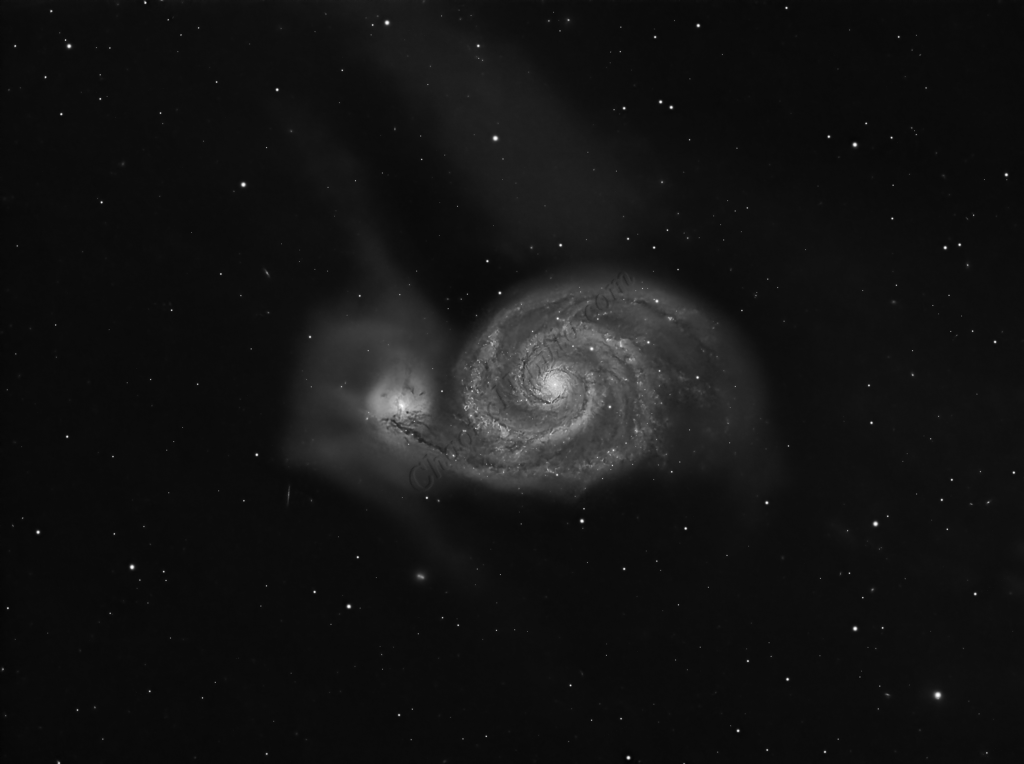
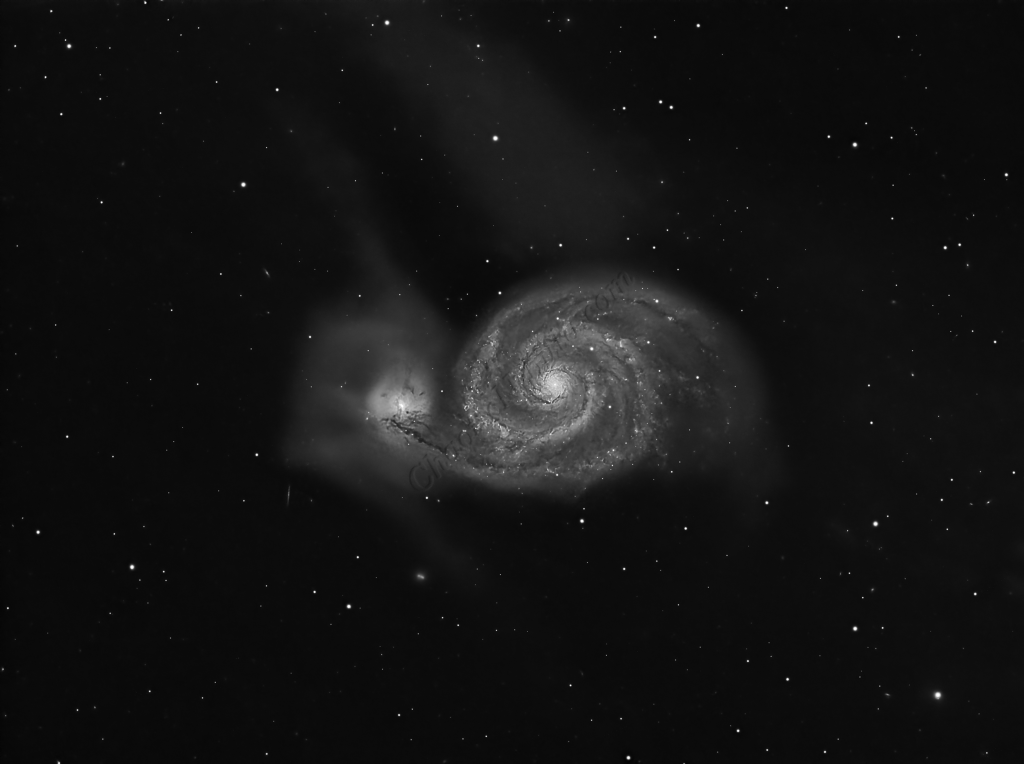
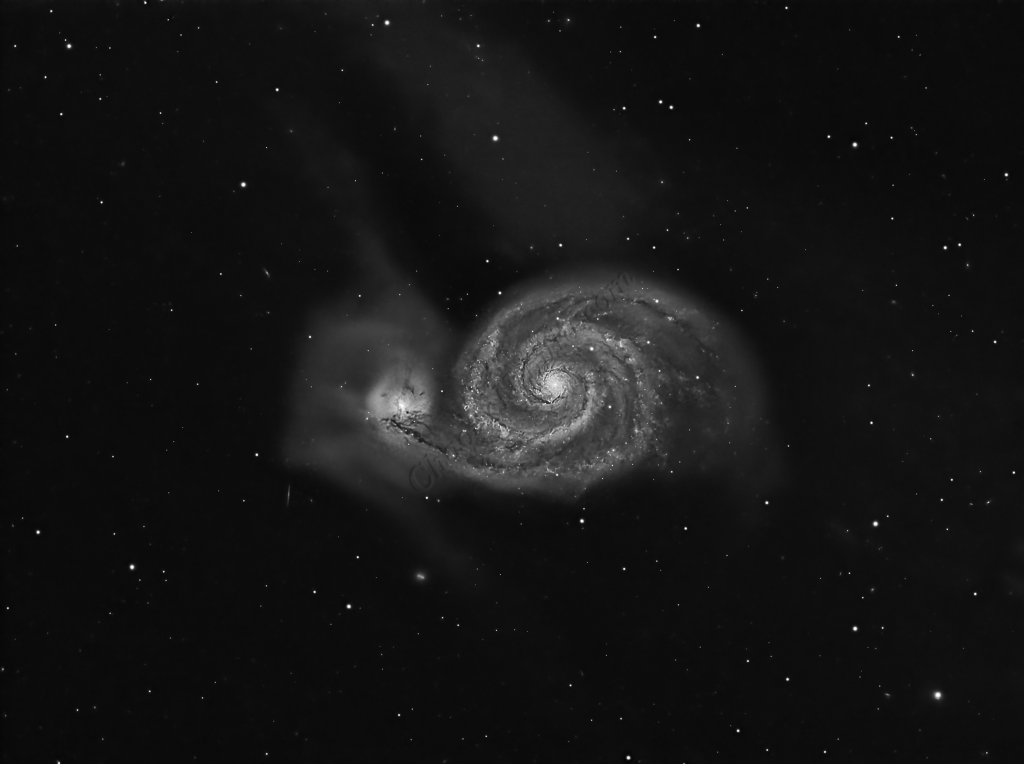
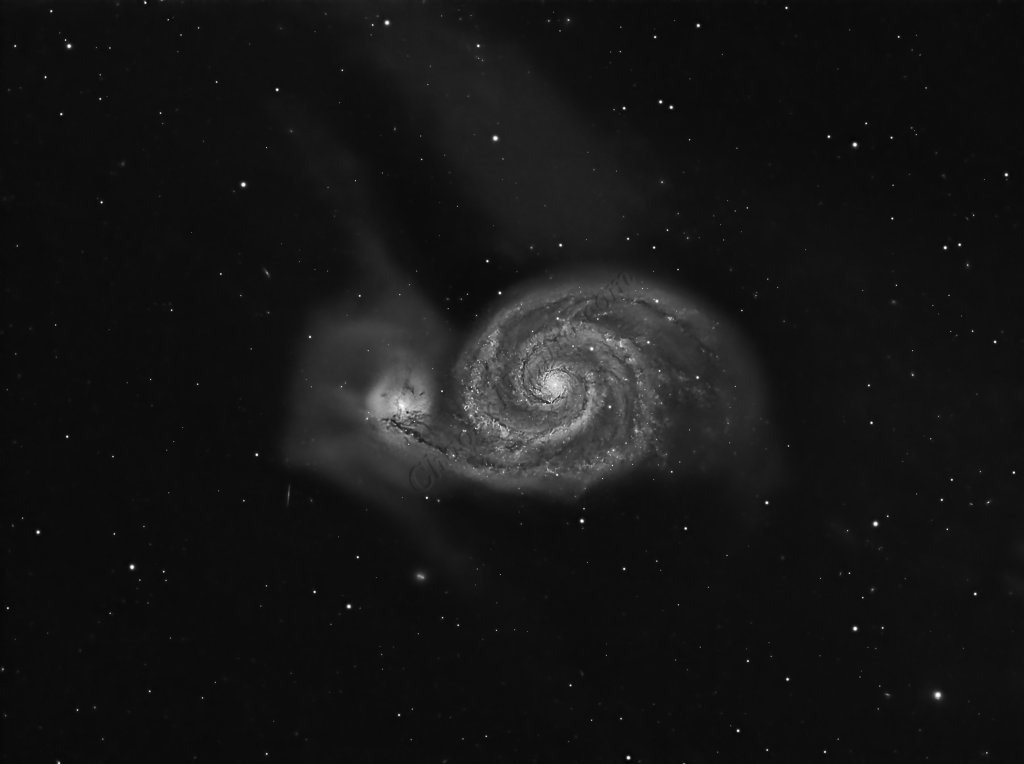
Luminance Integration (LRGB)
Saturation
PixInsight Curves Transformation increased the overall color saturation.
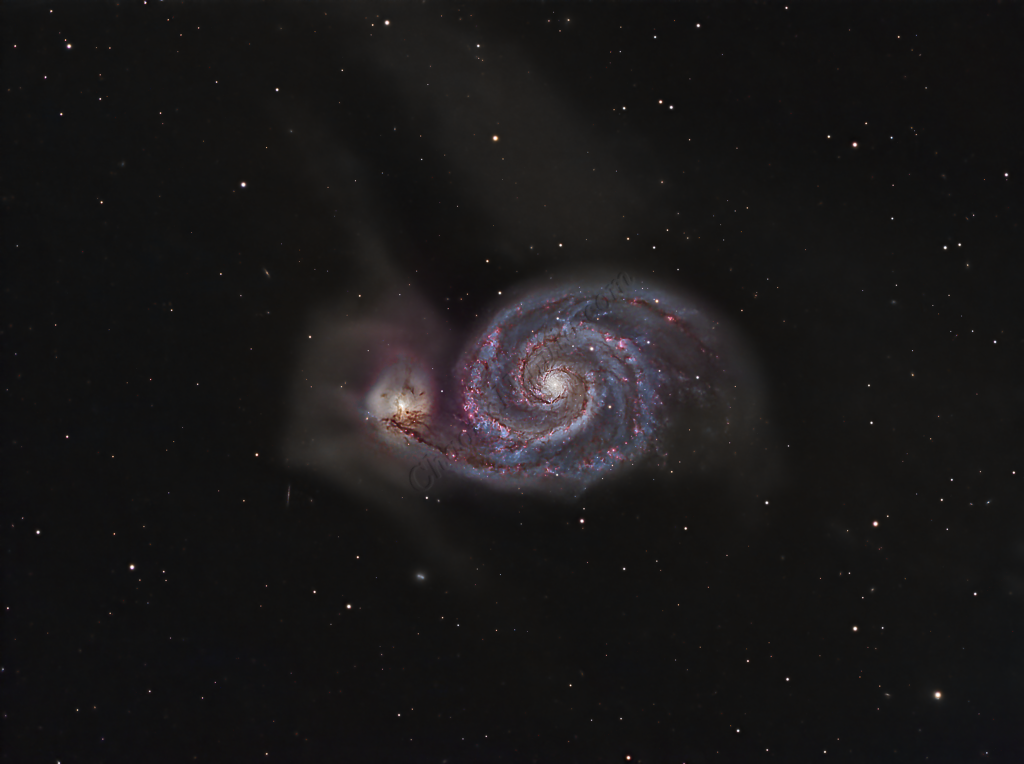
Brightness
PixInsight Curves Transformation increased the overall brightness.
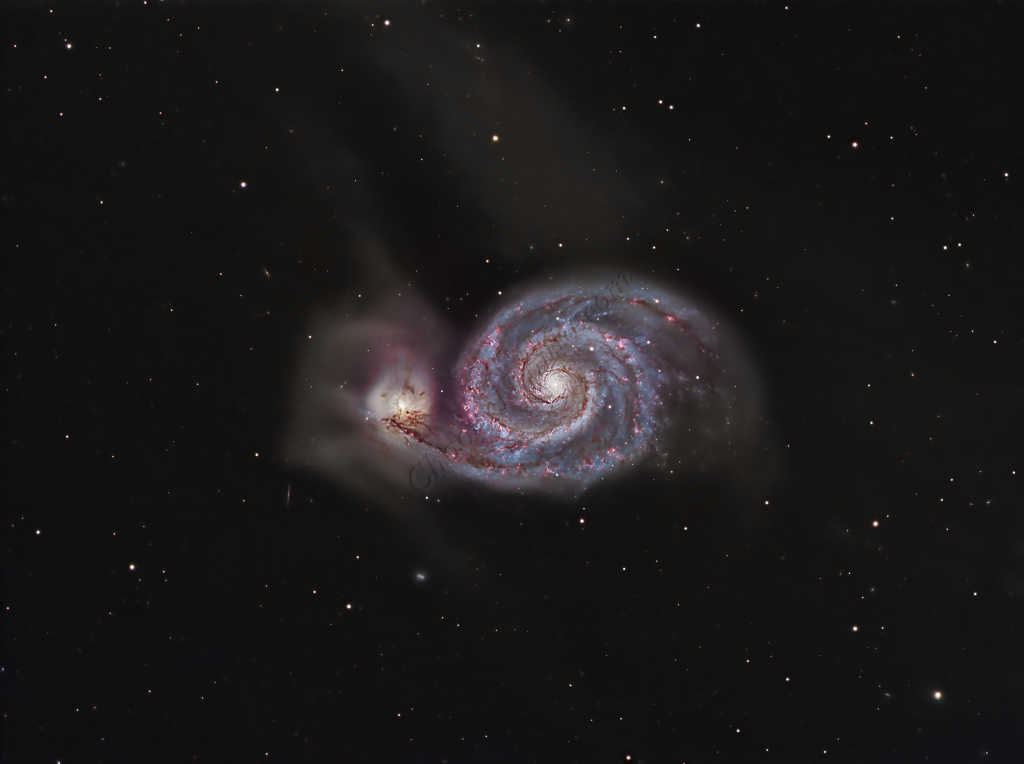
ACDNR for Chrominance
Although NoiseXTerminator did a great job in removing the noise from the image early on in the workflow, some of the processing might have added noise in the color. Applying ACDNR for only chrominance helps correct this without losing details.
